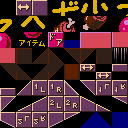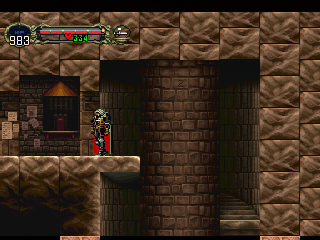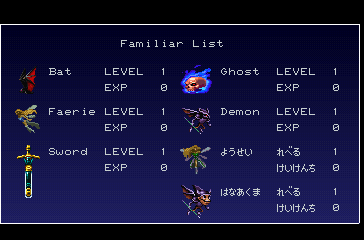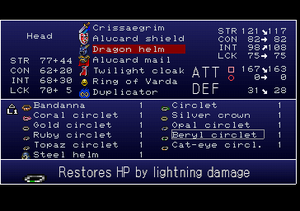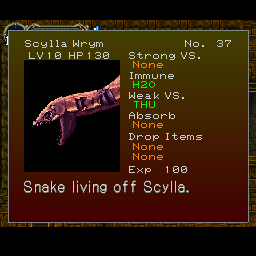Castlevania: Symphony of the Night (PlayStation)
| Castlevania: Symphony of the Night |
|---|
|
Also known as: Akumajou Dracula X: Gekka no Yasoukyoku (JP)
|
Castlevania: Symphony of the Night (Japan: "Demon Castle Dracula X: Nocturne in the Moonlight") was the first entry to use Metroid-style exploration, upgrades, and other aspects, thus "Metroidvania".
What is a game? A miserable little pile of secrets (that the programmers never expected you to find in the code)!
Contents
Sub-Pages
| Prototype Info |
| Unused Voice Clips Lots of assorted dialogue, including an unused ending! |
Unused Areas
Small Cave
| Entrance (PS1) | Reverse Entrance (PS1) | Entrance (Saturn) |
|---|---|---|
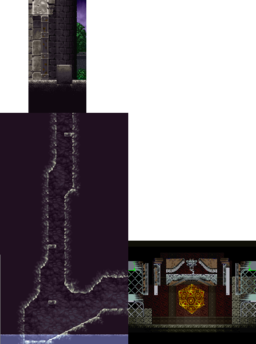
|
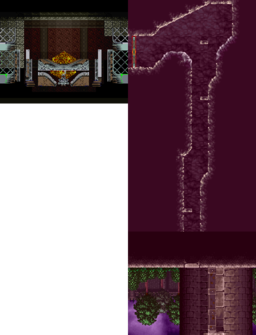
|
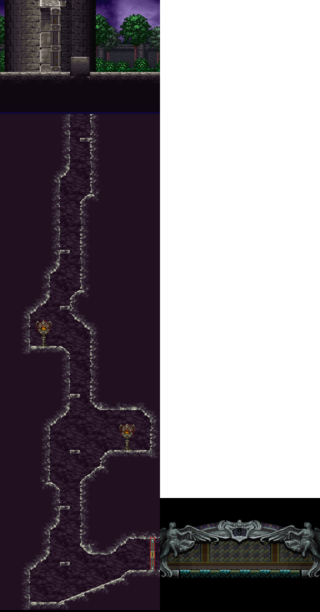
|
| L2+Up/Down Toggle No Walls |
Hatch Open (Alucard only) |
|---|---|
| D0097490 1001 800730A8 0000 D0097490 4001 800730A8 000F |
D00974A0 0007 80181104 0001 |
There's a small hatch in the ground at the entrance gate of the castle, which never opens at any point in the game. There is something beneath it, however, and it can be reached via glitches or by using GameShark codes to bypass the hatch. This hidden area consists of a small vertical cave with a save room at the end. Exiting the cave opens the hatch, allowing the area to be revisited normally. However, after visiting the Alchemy Laboratory or the Marble Gallery, the Entrance map is updated, the hatch is closed, and the save room in the cave visually glitches up, as shown above. Despite this, the save point still functions as it should.
The cave also exists in the inverted castle, but that version's hatch can never be opened due to what seems to be a missing helper entity. The inverted area is nearly identical, but has a reddish palette, no water at the "bottom", and a red "CD hall" door in front of the visually-glitched save room. Notably, despite the areas being inaccessible and having no real purpose, they do add a combined 0.6% to your map exploration total, which can increase your percentage past the typical max of 200.6%.
In the Saturn version, the hatch opens automatically after exiting to a new area, and the cave beneath has been modified: The water is no longer present, the exit has been moved about twice as far down, and breakable light posts have been added on some ledges. The save room has been replaced by a "CD hall" load room which leads to the Underground Garden (Hell Garden in the Inverted Castle), an area exclusive to the Saturn version.
Debug Area
A debug area can be entered from the title screen with GameShark codes 80097918 0040 800974A0 0040. It consists of the room seen in the screenshot, a load room missing its angel statue entities to the left of it, and eight interconnected double-width rooms to the right of it. Tiles are randomly placed in the small starting room to make a floor and ceiling, and four tiles are placed in each of the eight large rooms.
Exiting the left side of the load room or the bottom-left exit of the large rooms will return the player to the starting room.
"Hi, I'm Joji Yanami. I'm not a young man anymore. I've done this job for a long time. Eyup. I've done a lot of stupid roles. Man, though, this year has been so hot, I could die. It's way too much... I'm an old man, you see. I can't do anything anymore. It's exhausting. Someone save me, please. It's already September. I think something will come of all this, maybe. Old age is old age. Maybe not, though. Yeah. Well, that's all. See you, then."
This track plays upon entering the starting room of the debug area. It's actually one of the interviews present in the Japanese version, which cannot be accessed normally in the English versions.
Test Areas
There are five test areas. They all consist of the first room from the Marble Gallery repeated thirteen times, and all play the track "Lost Painting".
The area can be entered from the title screen with GameShark codes 80097918 0046 800974A0 0046
Unused Graphics
| To do: There are small icons in the font, probably earlier versions of the inventory icons. See if these display properly in-game. |
Richter Sprites
Palettes for several alternate color schemes are loaded when playing as or fighting Richter. The green and gray schemes are very similar to the palettes used in Castlevania: Rondo of Blood when he is cursed.
Unused animation of Richter doing some sort of spin jump. This was later used for his double jump in Castlevania: Portrait of Ruin, where he is an unlockable playable character.
Richter doing a spin kick. He later acquired this move in Portrait of Ruin.
Richter doing a sweep kick. Was later used as part of his hidden combo move in Portrait of Ruin minus the last frame, which in that game is actually occupied as an unused air dive kick attack startup that wouldn't make its debut until Castlevania: Harmony of Despair.
Another powerup sort of move of Richter doing punches at the air. It's similar to the animation he uses when powering up his whip and subweapons during the battle against him, but not the same.
A frame of Richter's stair climbing animation from Rondo of Blood and Castlevania: Dracula X. This was likely included by accident, since only a single frame is present and Symphony of the Night treats stairs like ramps.
Unused frames meant for use in the super jump special move. The last four sprites seem to be for after the landing. Portrait of Ruin uses the first four frames for his super jump and the last three for when he's dismissed when playing as Maria.
Frames of Richter getting hit and rolling. These are used in Rondo of Blood and Dracula X when he takes damage from certain enemies (such as the Behemoth), and in Portrait of Ruin as a landing animation when falling from a great height.


These frames seem to show Richter taking elemental damage such as electricity and being frozen in a block of ice. The first frame is used with an electrical overlay when Richter takes damage from certain enemies and obstacles in the Xbox Live Arcade version of the game, hinting at a possible intended use. Despite numerous palettes being loaded into VRAM when playing as Richter, none of them seem to fit the frozen sprite properly. The frozen sprite can actually be seen in-game by glitching Richter into the Lord Dracula battle; it uses his standard palette.
Item Graphics
Two books, one with a hand on the cover and the other with a "?". Can be found alongside the money, sub-weapons, and Life and Heart Max Up graphics.
A rainbow-colored potion. Could be a Magic Max Up potion, since it is found alongside the Life and Heart Max Up graphics.
Debug Tilesets
The complete tileset used in the aforementioned debug area. A number of tiles seen here are not present in the debug area itself, including "ボス" (boss) written in large letters, a red tile with "ドア" (door) written on it, a hunk of meat, and a red orb with "アイテム" (item) written underneath.
A much fancier marble version of the debug area tileset, found at the top of the tileset used in the center of the castle. This tileset features a wider variety of tile types including a candle, elemental symbols, a cracked tile, and the letters S A V E.
The first solid block of this tileset can be seen in the overscan in several areas of the Saturn version, such as the Colosseum. It's likely that the tileset was used to construct the rough outline of each area before the final tilesets were applied.
An evil-looking face and what appears to be a sword thrust into a pile of gold, found in the above tileset. The text at the top reads "ボス" (boss).
Unused Items
This flashing treasure chest is mixed in with the other "money" objects, and can be made to appear when candles are slashed. It gives you $5,000 when picked up, more than any other item in the game. It's a mystery as to why it was left unused, as it works perfectly and it's not as though there weren't places to put it. To change the item when smashing candles holding the Bibuti sub-weapon to this, use GameShark code 800769A4 000B.
There is a turkey in the game as an inventory item, but one can also be made to appear when candles are slashed, although it does nothing. Traditionally, meat restores some or all of your energy in Castlevania games, so this is likely a leftover from an early stage of development. To change the item when smashing candles holding the Bibuti sub-weapon to this, use GameShark code 800769A4 000D.
"No!" with a dark cross in the background. Can be equipped in Alucard's right hand and protects him from holy attacks.
Unused Music
Dracula Castle Remix
A Redbook Audio track that can be played directly from the game disc. It begins with a warning about playing the data track, then shifts into a remix of the Dracula's Castle theme. This track is not actually used in-game, and is just a small bonus.
Nocturne
This song is unused in the initial Japanese releases and the English releases. It was intended to be sung by the Sprite familiar, which is the case in the Japanese v1.2 release.
It is possible to enable the Sprite familiar to sing in the American version by using GameShark codes. First, enable the Sprite familiar using the GameShark code below, then enable the following codes and sit down in a chair in the Long Library:
D007342E 00DF
D00736CE 0089
D009797A 0301
800736F0 738C
D0138458 0104
D00974A0 0002
80138458 003F
Silence
This short song is present in the sound test, but it's not actually used anywhere.
Sequenced Tracks
Due to limitations of the PlayStation hardware, the game uses MIDI-like sequenced music tracks when voiced dialogue needs to be played at the same time. The only places in the final game where this applies are the Master Librarian's room and the confessional in the Royal Chapel (the Japanese version plays dialogue here).
Unknown Song
A gentle lullaby-like song, embedded in DRA.BIN in the root folder of the CD. An internal file listing suggests that this track's original filename was sd_eve1.seq (event 1?).
Unknown Jingle
A short song that resembles "stage clear" jingles used in previous Castlevania games, also found in DRA.BIN. Unfortunately, the instruments used in this recording may not be accurate; unlike the unknown song above, the original instrument IDs specified in the .SEQ file are either no longer present or were moved around in the final game, and attempting to play it back with the default set results in a cacophony of glass breaking and other unpleasant noises. The track's original filename was likely sd_eve3.seq (event 3?).
Unused Text
| This needs some investigation. Discuss ideas and findings on the talk page. Specifically: Does this string exist in the Japanese version? |
Found amongst the monster names is the string "Greater Demon". Logically, this would be a counterpart to the Lesser Demon. It may have even been intended for the Lesser Demon fought as a boss in the Long Library, since that one has slightly different abilities than the ones used as common monsters in the Necromancy Laboratory.
This string can be seen when fighting Dracula's final form during the intro stage, but only if the game is hacked to force Richter to have the Faerie Scroll enabled during the fight. Curiously, Dracula's first form doesn't have a name despite appearing in the Tactics and Enemy List.
Debug Functionalities
Hitbox Viewer
There is a debug functionality in the game that allows you to view the hitboxes of entities, such as those for Alucard, enemies, pickups, breakables, projectiles, attacks, etc.
Apparently, one of the two flags required for enabling this functionality is hardcoded to be disabled. However, this functionality can be fully restored by setting two flags to a non-zero value. GameShark codes 800BD1C0 0001 801362B0 0001 can be used to enable this functionality.
Debug Print Functions
There are debug print functions in the game, both via printf() to stdout and as a visual print to the screen.
For example, if decompression fails for any reason, the game will display text on screen that shows the address of the data that failed to decompress alongside the error code returned by the decompression function.
Pressing any buttons dismisses the screen and the game continues execution normally from that point.
The Wooden Bridge in Underground Caverns
To do:
|
In the Underground Caverns, there is a wooden bridge which is supposed to be destroyed by the barrel of a Skeleton Ape. However, pressing Triangle on the second player's controller will immediately destroy it and set the flag to spawn the Skeleton Ape in that same room. This only works in the PlayStation version and it doesn't work in the Skeleton Ape button room, but doing this anywhere else in the Underground Caverns will cause the flag to be set and the bridge to vanish.
Regional Differences
Japanese
Title Screen and Menus
| Japanese | English |
|---|---|
The Konami logo sequence was changed for the English versions. The original sequence had the red and orange logo "walk" across the Konami text with a silly sound effect. The English version is more elaborate, having rocks rise out of the ground, which fall over to reveal the Konami text. Both sequences end with the logo zooming in from the background, which then fades to white.
| Japanese | English |
|---|---|
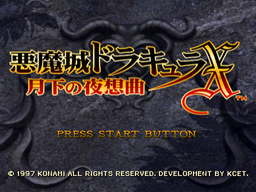 |
 |
Aside from the obvious logo change, the "PRESS START BUTTON" text was moved down slightly and the background was darkened in the English releases.
| Japanese | English |
|---|---|
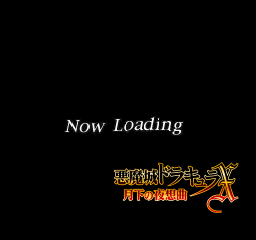 |
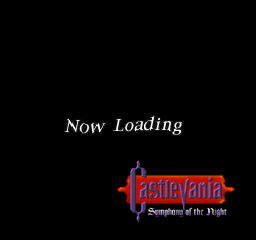 |
The logo on the loading screen was also changed.
| Japanese | English |
|---|---|
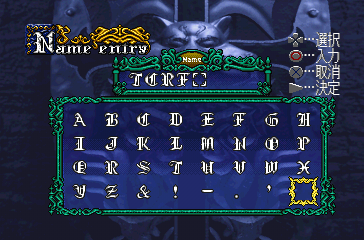 |
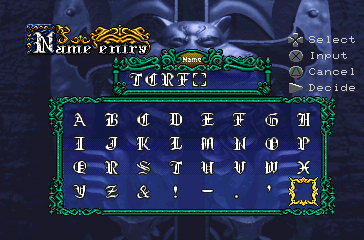 |
As is usually the case in PlayStation games, the button mappings were changed for the western releases. Confirm was changed from Circle to X, cancel from X to Triangle, and the button to sort weapons in the inventory from Triangle to Square. The buttons used during actual gameplay are unchanged.
| Japanese | English |
|---|---|
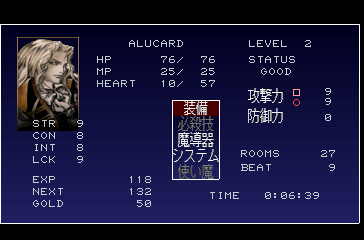 |
 |
The Japanese version grays out inaccessible options in the main menu, while the English versions black them out. The kill count is labeled "BEAT" in the Japanese version.
| Japanese | English |
|---|---|
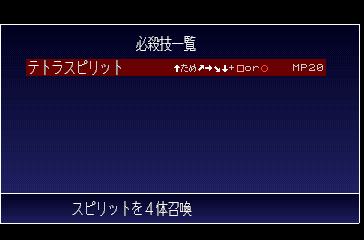 |
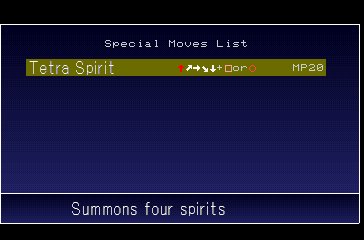 |
The Japanese version uses text to denote directions that need to be held in certain spells. Red arrows are used instead in the English versions. The color of the selection box used in this menu was also changed from red to yellow, likely to make the red arrows easier to see.
Intro
 The "journey back to 1792..." text before the opening FMV has a subtitle in the Japanese version.
The "journey back to 1792..." text before the opening FMV has a subtitle in the Japanese version.
While the intro text was always in English (and narrated in the Japanese version), parts of it were rewritten for the Western releases:
| Japanese | English |
|---|---|
| After a series of epic battles, Richter Belmont finally succeeded However, one night 4 years later, With no idea of where to begin Castlevania, the castle of Dracula, Meanwhile, powerful forces The very same Alucard who had Alucard, in order to rid the world of But now, that sleep has been disturbed The time has come once more for And perhaps none but that bright and |
It was Richter Belmont, the legendary vampire hunter, However, one night 4 years later, With no idea of where to begin Castlevania, the castle of Dracula, Meanwhile, powerful forces were Alucard, in order to purge the world This time has once again come for And no man can say who shall |
| Japanese | English |
|---|---|
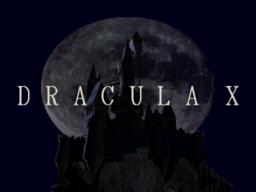 |
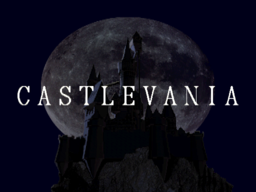 |
The Japanese version shows a Dracula X graphic after the intro text. The English versions replaced this with a Castlevania graphic.
Area Names
| Japanese | English |
|---|---|
| Olrox's Room | Olrox's Quarters |
| Ground Water Vein | Underground Cavern |
| Abandoned Pit to the Catacomb | Abandoned Mine |
| Catacomb | Catacombs |
All of the graphics used for introducing areas in the normal castle have an English subtitle of the area name in the Japanese version. Some of these names were still changed for the English releases, however.
The English releases of the game also replaced these graphics and the effects used when they appear and fade away. The Japanese version uses two different effects depending on the area: One where the graphic "rolls" to the front of the screen, then to the back; and another where it's drawn from one side and fades to the other. The former style is only used for the Alchemy Laboratory and Abandoned Mine. The English version always has the graphic fade in, then disintegrate to the sides.
Game Over
In the Japanese versions, getting a game over at certain points in the story will result in a voiceover from one of the characters replacing the standard game over music.
There are 8 voiceovers:
- Maria: it happens randomly after speaking with her at clock room in Marble Gallery. Just die anywhere in the game - except for the bosses places below - and then you may get Maria voiceover.
- Succubus: Die against the Succubus.
- Richter: Die against Richter. There are 3 different voiceovers.
- Death: Die against Death. There are 3 different voiceovers.
None of these are used in the English versions, despite Maria, Succubus and Richter ones having been translated.
| Japanese Rev 0 and 1 | All Subsequent Releases |
|---|---|
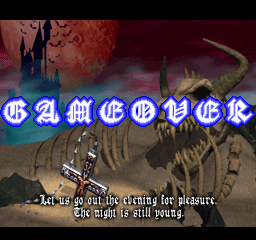 |
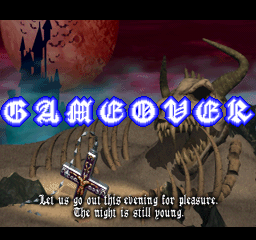 |
The Japanese revision 0 and 1 game over screen has the text "Let us go out the evening for pleasure. The night is still young." Starting with the North American release, the first "the" was changed to "this".
Removed Familiars
| To do: The Nosedevil is supposedly a reference to one of the Japanese voice actors. Can anyone confirm this? |
Two familiars were removed from the original English release - they are counterparts to the Faerie and Demon, but have different voice actors. Their names were not translated on the Familiar Menu, but the cards that activate them call them the Sprite (or Pixie, in its description) and Nosedevil. They were later translated as Fairy and Nose Demon in the Dracula X Chronicles version for the PSP.
The Nosedevil has no new abilities, but the Sprite will sing when Alucard sits in a chair in the Japanese "The Best" rerelease, the Saturn version when the lyrics card has been obtained, and Dracula X Chronicles and its further releases.
The programming for these familiars is still present in the English PlayStation versions and can be activated with GameShark codes, but their cards were removed from the game and they will leave once the player changes their familiar settings. To enable the Japanese familiars in the US version using a GameShark, first make sure no familiars are enabled on your save file, then use GameShark code 8009797A 0301 for the Sprite/Pixie or 8009797C 0303 for the Nosedevil.
| To do: "May"? Confirm this. |
Their relics may have to have been acquired first to enable them. This can only be done by using a GameShark code to acquire all relics. However, the all relics code must be off when using the code to enable a familiar, meaning you must first use the all relics code, save, restart the game, disable all familiars, save, then restart the game again with the familiar enable code entered.
| Japanese | English |
|---|---|
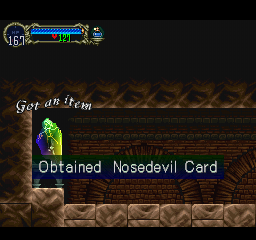
|
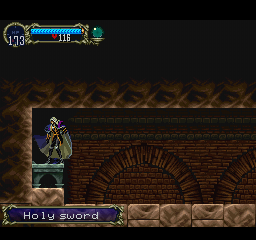
|
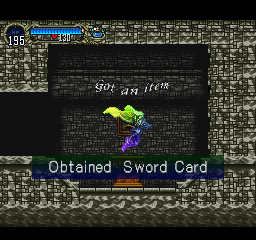
|
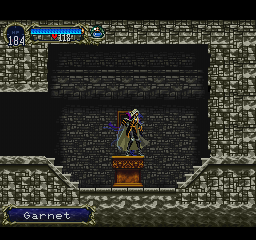
|

|
The removal of these familiars resulted in some items getting slightly rearranged for the English releases: The Nosedevil Card was found in the hidden area where the holy sword is in the Colosseum. Notably, the only way to get the holy sword in the Japanese version is to have a Vandal Sword drop one on death. The Sprite Card was found in the hidden area where the Sword Card is in Olrox's Quarters. The Sword Card wasn't originally hidden, being placed in a normal room in Olrox's Quarters where a common garnet is found now. (The English screenshots on the left are taken from the E3 version, which uses the same item placements as the Japanese version.)
Interviews/Sound Test
After exploring 196% or more of the castle maps and completing the game, a new option will become available in the Master Librarian's menu.

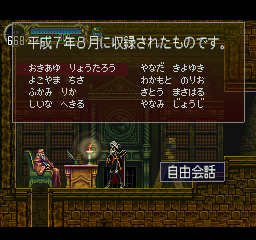
In the Japanese version, there are eight interviews with the voice actors.


In the English versions, a sound test takes the place of these interviews. All of the game's music tracks can be played, with the exception of the Redbook Audio track, Nocturne, and the unknown song.
Soft Reset Method
In the Japanese version, the player must press L1 + R1 + L2 + R2 + Start + Select simultaneously to soft reset the game. The English versions simplified this to holding Start + Select for a brief time.
European Version
This piracy warning screen is shown before the Konami logo sequence in the European version. The TIM for it is present in the US and Japanese v1.2 versions, but it's never displayed.
Text Changes
| Item | US | Europe |
|---|---|---|
| Resist ice | Brief resistance to ice [use] | Resistance to ice [use] |
| Resist fire | Brief resistance to fire [use] | Resistance to fire [use] |
| Beryl circlet | Heals HP by lightning damage | Restores HP by lightning damage |
Several items' descriptions were updated to be consistent with the rest of the descriptions.
| US | Europe |
|---|---|
| Defeat Ralph, Grant & Sypha | Defeat Trevor, Grant & Sypha |
| Defeat Slogra and Gaibon | Defeat Slogra & Gaibon |
| Defeat Minotaur and Werewolf | Defeat Minotaur & Werewolf |
Most notably, the only case of Ralph's name not being localized in the English version was fixed in the Time Attack menu.
| US | Europe |
|---|---|
| Minotaur | [see below] |
| Cerberos | Cerberus |
| Beezelbub | Beelzebub |
| Scylla Wyrm | Scylla Wrym |
| Minotaurus | Minotaur |
While spelled correctly elsewhere, several monster names were originally misspelled in the strings used by the Faerie Scroll relic and enemy list. Strangely, a new typo, Wrym, was added in the European version despite being spelled correctly in the American version. The Minotaurus boss (brown) and common Minotaur enemies (purplish) were made to share a string in the European version, since the boss is called Minotaur everywhere else.
Revisional Differences
The Japanese version had three different releases. Which one you have can be determined by the edit date of the SLPM_860.23 file in the ISO.
| Version | SLPM_860.23 Date | Title Sound Settings? | Richter vs. Dracula? | Repeat Wing Smash? |
|---|---|---|---|---|
| v1.0 | 1997/02/19 | No | Yes | No |
| v1.1 | 1997/03/06 | No | No | Yes |
| v1.2 | 1998/01/19 | Yes | No | Yes |
v1.0 was the initial retail release. v1.1 is a patching release shortly afterwards. v1.2 includes "the Best" and the "PSOne Books" Japanese versions, and was also used for the English versions.
- Richter vs. Dracula: Only available in v1.0. At above the castle center room (where you are supposed to fight Shaft inside), stand at the left of the entrance with a width of one Richter, then backflip into the room and perform a flying slide to the left. If done correctly, Richter will enter the fight with True Dracula (while showing the otherwise-unused "frozen" sprite). The game will freeze when the fight ends.
- Fire Warg and Karma Coin: The Fire Warg will never yield its hidden drop, Karma Coin, in v1.0. v1.1 fixed this bug.
- Repeat Wing Smash: Since v 1.1, Alucard can cast another Wing Smash before the forehand one ends.
- The Sega Saturn version is also different, in that a single cast will charge endlessly and consume MP accordingly until hitting a wall or being cancelled.
- Swap Overflow Shenanigans: A glitch only found in v1.1 - by swapping items repeatly, the game may cause overflows, including a possible "game end glitch".
- Sound Settings: Added in v1.2. On the title screen, press Select to reveal an option to set game sound between Stereo and Monaural.
- Fire Boomerang Super Jump: A glitch available in v1.2 - let Alucard equip Fire Boomerang in both hands, then do the following quickly: "Throw 6 boomerangs, jump / back dash, bat / wolf transform". If done correctly, the distance of jumping / back dashing will be greatly increased.
- Trying to perform this glitch in v1.0 or v1.1 (and even the Saturn version) will freeze the game eventually.
- Richter's flame whip, activated by pressing Triangle without a subweapon equipped, has been changed from holy to fire elemental. The flame whip has no advantages over the normal whip in the other versions.
- The Sprite familiar can sing the previously-unused Nocturne song in Japanese v1.2. Simply have Alucard sit in a chair until she sits on his shoulder, then wait a while longer and she'll begin singing.
- In the Saturn version, this requires having the Lyric Card equipped.
- This feature is removed in mobile releases due to copyright issues.
- As with the English releases of the game, the text "the evening" on the game over screen has been corrected to "this evening".
- For some reason, the misplaced damage attribute of Tombstones and Archers in Japanese v1.0 version were set back, in order to match the situations in other Western releases.
| Japanese v1.0 | English/Japanese v1.2 | |
|---|---|---|
| Tombstone | 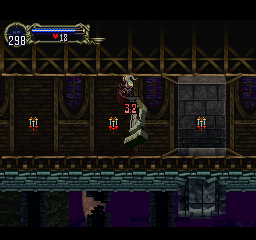
|

|
| Archer | 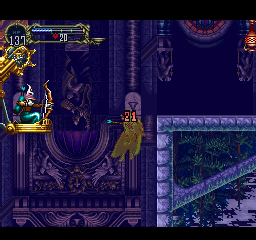
|

|
Oddities
Gargoyle Statue
Not unused, but occurs very rarely: Whenever Alucard is petrified, there's a slight chance he'll turn into a gargoyle statue instead of his normal petrified form. Notably, while he normally takes several times the normal amount of damage if hit by an enemy while petrified, he is invulnerable to enemy attacks in this form.
- Pages missing developer references
- Games developed by Konami Computer Entertainment Tokyo
- Pages missing publisher references
- Games published by Konami
- PlayStation games
- Pages missing date references
- Games released in 1997
- Games released in March
- Games released on March 20
- Games released in October
- Games released on October 2
- Games released in November
- Games with unused areas
- Games with unused graphics
- Games with unused items
- Games with unused music
- Games with unused text
- Games with regional differences
- Games with revisional differences
- Games with hidden bonus content
- Pages with a Data Crystal link
- To do
- To investigate
- Castlevania series
Cleanup > Pages missing date references
Cleanup > Pages missing developer references
Cleanup > Pages missing publisher references
Cleanup > To do
Cleanup > To investigate
Games > Games by content > Games with hidden bonus content
Games > Games by content > Games with regional differences
Games > Games by content > Games with revisional differences
Games > Games by content > Games with unused areas
Games > Games by content > Games with unused graphics
Games > Games by content > Games with unused items
Games > Games by content > Games with unused music
Games > Games by content > Games with unused text
Games > Games by content > Pages with a Data Crystal link
Games > Games by developer > Games developed by Konami > Games developed by Konami Computer Entertainment Tokyo
Games > Games by platform > PlayStation games
Games > Games by publisher > Games published by Konami
Games > Games by release date > Games released in 1997
Games > Games by release date > Games released in March
Games > Games by release date > Games released in March > Games released on March 20
Games > Games by release date > Games released in November
Games > Games by release date > Games released in October
Games > Games by release date > Games released in October > Games released on October 2
Games > Games by series > Castlevania series











